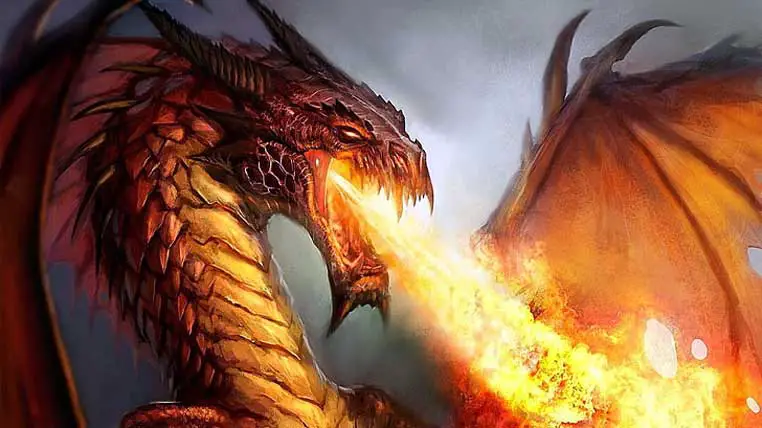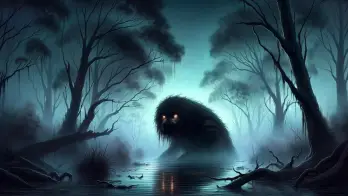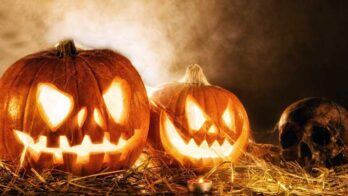The dragon symbolism is powerful amidst the folklore creatures found in legends and tales across the globe, as it stands out as the most fearsome and revered of them all.
Dragons have been depicted as powerful, mystical creatures with a range of qualities, from terrifying and destructive to wise and benevolent. As symbols, they have taken on a variety of meanings, representing everything from strength and power to chaos and evil.
In this article, we will explore the rich history of dragon symbolism and answer some important questions about these legendary creatures.
Dragon symbolism: meaning and interpretation
Dragons have long been associated with fantasy and magic.
These mythical creatures are often portrayed as the ultimate villains in fairy tales, with knights destined to slay them and kingdoms brought low by their might and power.
However, they also represent unconquerable adversity, embodying the difficult circumstances one must overcome in order to succeed.
In ancient myths, these legendary creatures were depicted as guardians of princesses, which could symbolize feelings of captivity or being trapped. But they can also represent protection, defense, or power, depending on the context in which they appear.
Similarly, dragon symbolism is widely used in mythology.
Greek and Roman mythology
For the Egyptians, for instance, it represented the figure of a protective goddess whose body was comprised of parts of a crocodile, a man, a lion, and a hippopotamus.
In Greek mythology, Heracles must contend with Ladon, a serpent-like monster with many heads, to steal the Golden Apples from the Garden of the Hesperides.
Heracles managed to lure the creature with music and put it to sleep so he could steal the golden apples. Hera then placed Ladon in a constellation out of mercy.
Similarly, Beowulf battles a fearsome dragon in its treasure hoard.
There is even a Roman legend in which Draco was killed by the goddess Minerva and thrown into the sky after his defeat, along with many other myths.
These stories, like many others, connect dragons with greed and selfishness.
Dragons are also associated with extreme weather conditions and are sometimes thought to control the winds or bring storms. In general, they represent the legendary powers of the forces of nature.
Despite their fearsome reputation, dragons are often associated with innocence, imagination, and childhood. They are considered regal and majestic and can be connected with kingship, leadership, or adventure.
Dragons are often portrayed as breathing fire, symbolizing elemental fire. Fire can be destructive, but it can also be a force of renewal and purification.
As a result, the dragon’s symbolism can be linked to death, destruction, rebirth, and rejuvenation.
Medieval symbolism
In medieval symbolism, dragons symbolized apostasy, betrayal, perfidy, anger, and envy. The creature was also linked with natural disasters, and the multiple heads of the dragon were a symbol of decay, oppression, and even heresy.
Nevertheless, some European peoples saw the dragon as a symbol of independence, sovereignty, and power.
The dragon can also symbolize intelligence; by defeating this legendary monster, fairy tale heroes not only gain access to the treasure guarded by it but symbolically defeat one of the most cunning beasts.
Dragon symbolism in Christian literature
Finally, dragons are sometimes associated with evil, the devil, or deception. They are often depicted as serpent-like, and sometimes, the dragon symbolism can be linked with the biblical concept of sin.
For instance, we see the dragon symbolism in “Psalm 73,” where the dragon is a demonic symbol identified with the serpent.
In fact, its heads crushed and serpents destroyed represent Christ’s triumph over evil. In addition to the famous images of Archangel Michael and Saint George overcoming dragon-like creatures, we sometimes see art representations of Christ himself crushing them underfoot.
Asian mythology
In the Far East, this mythical creature appears in various forms.
It is simultaneously an aquatic, terrestrial, and even subterranean, but also heavenly animal, which is why it could be compared to Quetzalcoatl, the feathered serpent of the Aztecs. This ambiguity represents different aspects of a single symbol: that of divine power.
Hindu doctrine identifies this mythical monster with the Principle, Agni, or Prajapati. The dragon slayer is the sacrificer who subdues divine power and identifies with it.
According to the Chinese philosopher Zhuangzi, the dragon’s power is mysterious: it represents the resolution of the conflict of opposites.
Is the dragon symbolism good or bad?
Dragons have been depicted positively and negatively throughout history, making it difficult to assign a singular meaning to these creatures as symbols. In some cultures, they are revered and respected as protectors, while in others they are feared and seen as destructive forces.
In Chinese culture, these creatures are generally considered to be good symbols associated with prosperity, power, and good fortune.
They are believed to be benevolent creatures that bring rain, wisdom, and blessings to the land.
On the other hand, in Western cultures, dragons are often seen as evil or malevolent creatures associated with chaos, destruction, and greed. They are typically depicted as fire-breathing monsters that must be slain by a hero or a knight in shining armor.
However, it’s important to note that the symbolism of dragons is not always so clear-cut. In some cultures, they are seen as having positive and negative qualities, embodying creation and destruction.
For example, in Hindu mythology, dragons (or nāgas) are seen as powerful and wise beings that possess both benevolent and malevolent aspects.
Furthermore, dragon symbolism has evolved over time and varies across cultures.
For instance, these creatures depicted in medieval European literature were often associated with the devil and were seen as agents of chaos and destruction.
In contrast, dragons in modern Western literature and popular culture are often portrayed as heroic figures, fighting against evil and protecting the innocent.
What does the dragon symbolize in literature?
Dragons have long been a popular subject in literature, appearing in many stories and myths. In literature, they have been portrayed in various ways, including as villains, allies, or even as the story’s main characters.
One of the most famous literary dragons is Smaug, a central character in J.R.R. Tolkien’s “The Hobbit.”
Smaug is depicted as a cunning and malevolent creature, guarding a vast hoard of treasure deep in the Lonely Mountain. He is a symbol of greed and avarice, and his presence in the story represents the danger of unchecked ambition.
In contrast, the serpent in Kenneth Grahame’s “The Reluctant Dragon” is a gentle and pacifist creature who prefers to write poetry and engage in intellectual pursuits rather than engage in combat.
In this story, the monster represents the power of imagination and the potential for peaceful coexistence between different species.
In the Harry Potter series by J.K. Rowling, dragons are portrayed as fierce and powerful creatures that are both feared and respected by wizards. They symbolize strength and power, and their presence adds an element of danger and excitement to the story.
Other examples of famous dragons in literature include Puff the Magic Dragon, the monster in E. Nesbit’s “The Book of Dragons,” and the creature in Ursula K. Le Guin’s “Earthsea” series.
Each of these beasts has a unique symbolic meaning, representing different aspects of human nature, such as innocence, power, and wisdom.
What does dragon energy symbolize?
Dragon energy is a concept that has gained popularity in recent years, especially in the realm of spirituality and self-improvement. It is often described as a powerful force that can be harnessed to achieve personal growth and transformation.
At its core, dragon energy represents strength, courage, and resilience. It is associated with the primal forces of nature and the power of creation. Those seeking to harness this energy often tap into their inner strength and creativity.
Dragon energy is often used as a metaphor for the transformative power of change. Just as a dragon must undergo a process of metamorphosis to grow and develop, so too must individuals undergo a process of personal growth and transformation to reach their full potential.
To harness the energy, individuals are encouraged to cultivate certain qualities such as courage, determination, and a willingness to take risks. By tapping into these qualities, individuals can unleash their full potential and achieve their goals.
In some traditions, dragon energy is associated with the body’s chakras, or energy centers. It is believed that by focusing on the chakras related to the dragon, individuals can access the full power of this energy and use it to achieve their goals.
Is a dragon a symbol of protection?
Throughout history, dragons have been associated with protection and depicted as guardians and defenders in many cultures.
In Chinese mythology, these creatures were seen as protectors of the Emperor and his realm, and their images were used to ward off evil spirits and bring good fortune.
It was believed that the presence of a dragon would ensure safety and protection for those who lived within its territory.
Similarly, European folklore often saw them as protectors of treasure or territory. They were believed to guard precious objects or important locations, and only brave and worthy people could access them.
In some stories, they were even seen as allies of knights and other heroic figures, lending their strength and magical powers to defend the realm.
In modern times, dragons continue to be seen as symbols of protection. In popular culture, they are often depicted as heroic figures, using their strength and magical powers to protect the innocent and defend the realm against evil forces.
Short conclusion
As explored in this article, dragon symbolism is a multifaceted concept with deep historical and cultural roots.
From its origins as a fierce and powerful creature in ancient mythology to its recent associations with personal growth and transformation, the dragon has remained a symbol of enduring significance throughout human history.
Despite the varied meanings and interpretations of dragon symbolism, one thing remains clear: the dragon is a powerful and enduring symbol that has captured the human imagination for centuries.
At Ancient Theory we only use trusted sources to document our articles. Such relevant sources include authentic documents, newspaper and magazine articles, established authors, or reputable websites.
- Chinese dragon. wikipedia.org. [Source]
- Ernest Ingersoll - Dragons and Dragon Lore. D. Appleton and Company, 1928.
- John Lindow - Norse Mythology: A Guide to Gods, Heroes, Rituals, and Beliefs. Oxford University Press, 2002.
- M. E. Snodgrass - The Symbolism of the Stupa. Cornell University Press, 1985.
- Joseph Campbell - The Hero with a Thousand Faces. Princeton University Press, 1949.
- T. A. Sinclair - Eastern Mythology: A Lavishly Illustrated Reference to the Legendary Gods, Heroes, Warriors, and Monsters of Asia. Sterling, 2001.
- Richard Cavendish - Mythology: An Illustrated Encyclopedia of the Principal Myths and Religions of the World. Little, Brown, and Company, 1980.






